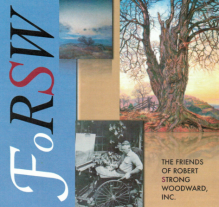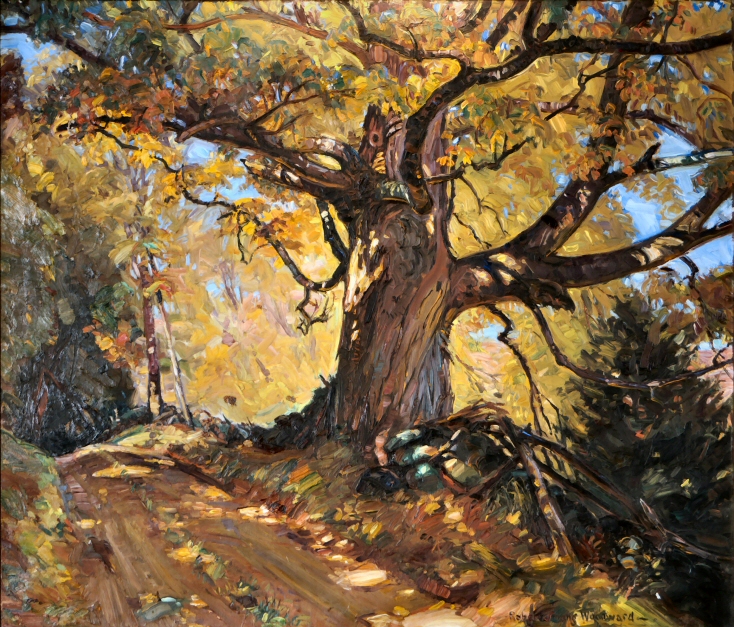Quick Reference
c. 1929
Conway, MA
Oil on Canvas
Landscape
Trees, Autumn, Road
36" x 42"
Art Week- Jordan Marsh, 1930
Myles Standish Galleries, 1930
Springfield Art league, 1930
Stockbridge (MA) AA, 1932
Mrs. Henry P. Everett
Mrs. H.A. Everett Collection
San Diego Museum of Fine Art
CalTech Collection 1980 - ?
Joseph Holland
Related Links
- See also the...
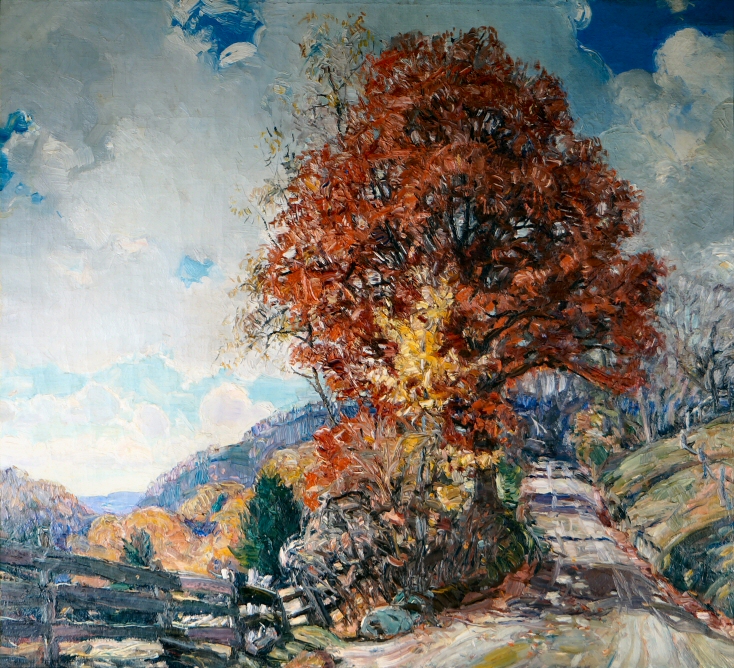 Burning Autumn Gallery to view related pieces.
Burning Autumn Gallery to view related pieces.
- See also the...
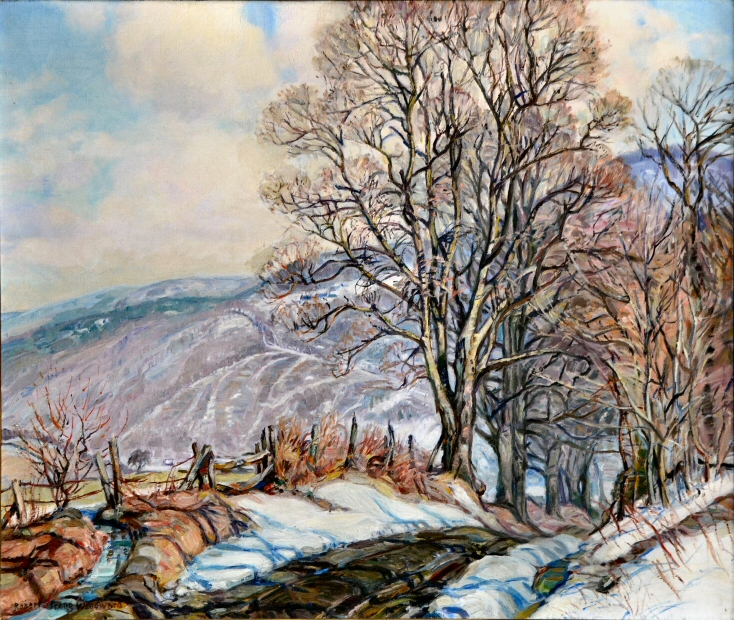 Roads & Streets Gallery to view related pieces.
Roads & Streets Gallery to view related pieces.
- See also the...
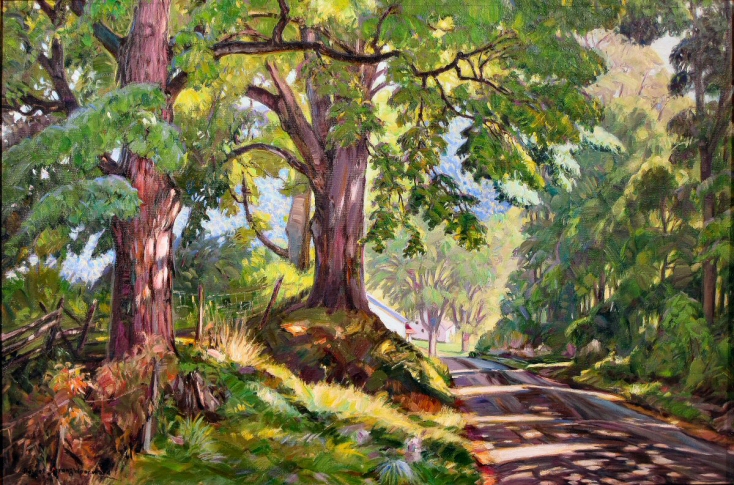 Trees Gallery to view related pieces.
Trees Gallery to view related pieces.
- See also the...
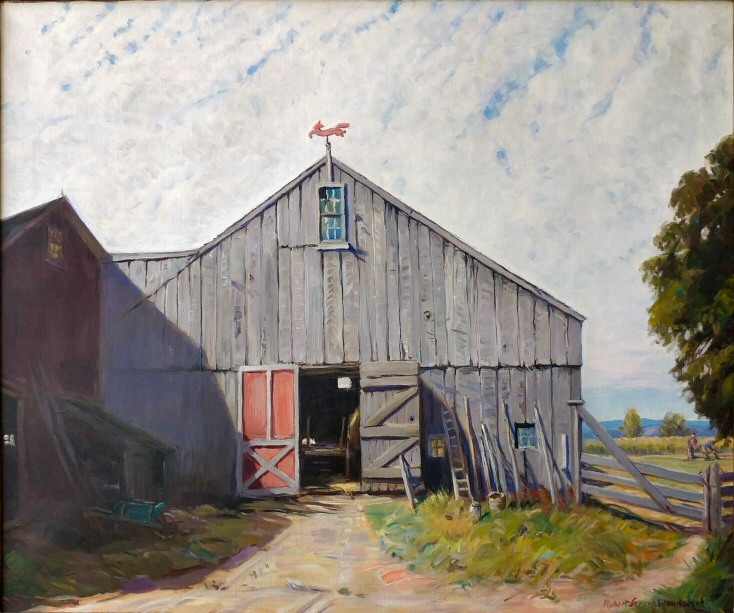 Fences, Gates & Doors Gallery to view related pieces.
Fences, Gates & Doors Gallery to view related pieces.
- See our page devoted to ...
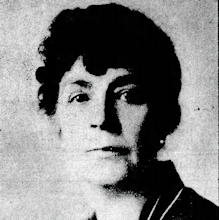 RSW patron Mrs. Everett
RSW patron Mrs. Everett
- See also the...
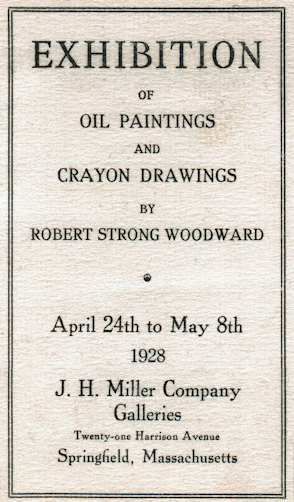 Exhibition List for a complete list of events
Exhibition List for a complete list of events
- See also the...
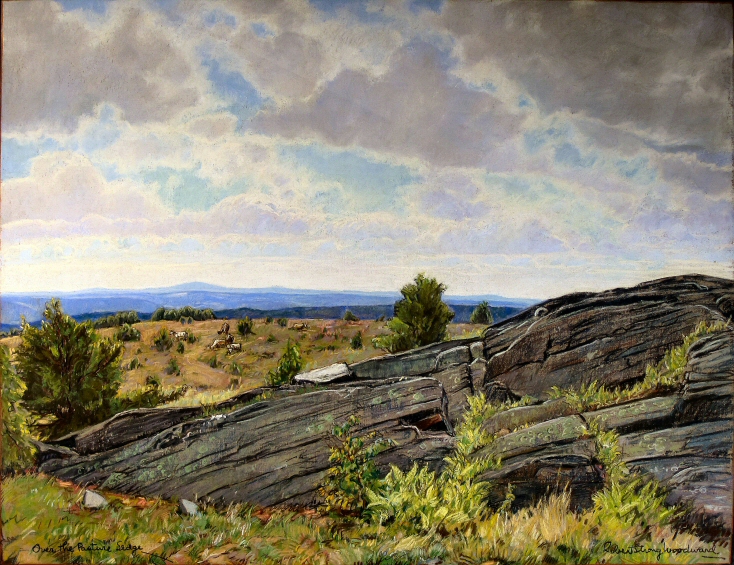 Rocks & Stone Walls Gallery to view related pieces.
Rocks & Stone Walls Gallery to view related pieces.
- See also the...
 Burning Autumn Gallery to view related pieces.
Burning Autumn Gallery to view related pieces.
- See also the...
 Roads & Streets Gallery to view related pieces.
Roads & Streets Gallery to view related pieces.
- See also the...
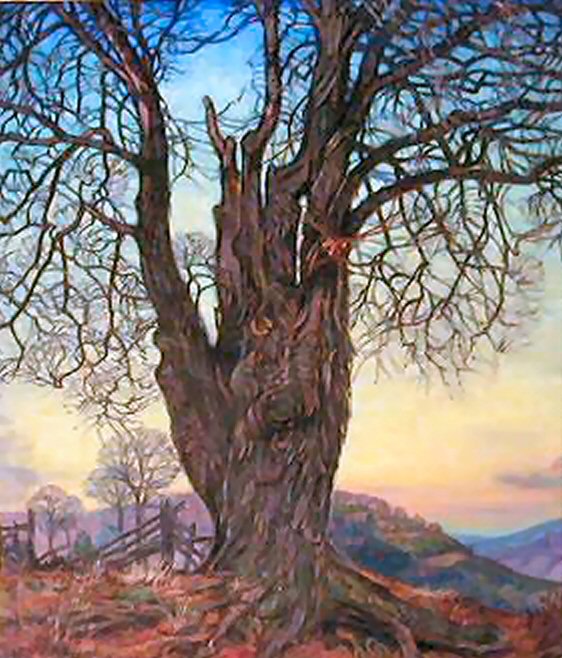 Trees Gallery to view related pieces.
Trees Gallery to view related pieces.
- See also RSW's ...
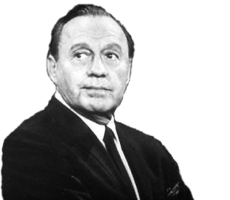 Famous Owners Gallery
Famous Owners Gallery
- Visit Our Essay ...
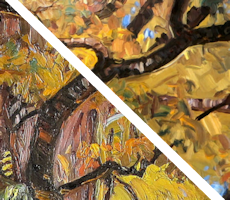 on RSW's Brush Style
on RSW's Brush Style
- See also the...
 Exhibition List for a complete list of events
Exhibition List for a complete list of events
Featured Artwork: October Gold
RSW's Diary Comments

 An October Gold, c. 1927 unnamed 27" x 30"
An October Gold, c. 1927 unnamed 27" x 30"
This once unnamed painting had no markings or
known history. It is remarkably similar to the named
painting but in a more impressionistic brush style.
"Painted in fall of 1929. A painting made of a giant old maple tree (shaped like an oak) in brilliant foliage on back road from Ashfield to Conway near Pine Hill where Archibald MacLeish lives. Sold to Mrs. Henry P. Everett, the prominent collector of Cleveland, Ohio, and Pasadena, California. At her death, in the late 30's it was willed to the permanent collection of the San Diego Art Museum in San Diego, California."
Editor's Note ⮞
For many years, another painting of the same subject was thought to be this
painting but its size did not match the one of record and Woodward makes no mention of a
second painting of the same subject in his painting diary entry. It was not until the owners of
the canvas seen above contacted us that we began to unravel the mystery. Fortunately for us
the current owner was able to provide some provenance and the stretcher was well marked to
fill in other blanks.
See more below ⮟
Additional Notes

 Boston Globe, March 3, 1930
Boston Globe, March 3, 1930
Right: The Boston Globe, Monday, March 3, 1930
"October Gold by Robert Strong Woodward, showing an oak tree by the roadside in the hills, in Autumn, is one of the most vital pictures in the exhibition --- a vigorous presentation." (Jordan Marsh Exhibition March, 1930)
 There is so much to say about October Gold. First, this
particular painting was not discovered until it's current owners contacted the website (2015). It was then, with
the confirmation of the name on the back of the stretcher and it matching the size noted in RSW's records we
realized that the painting bought at auction in Mystic, CT and
believed to be October Gold, is, in fact, is an unknown named painting of the same subject.
There is so much to say about October Gold. First, this
particular painting was not discovered until it's current owners contacted the website (2015). It was then, with
the confirmation of the name on the back of the stretcher and it matching the size noted in RSW's records we
realized that the painting bought at auction in Mystic, CT and
believed to be October Gold, is, in fact, is an unknown named painting of the same subject.
There are differences between the two paintings when examined more closely. The most striking is they were
painted in different styles. The painting October Gold, purchased in Mystic and now known as
An October Gold is distinctly a style Woodward used from the years 1923 to just around 1928-9.
This piece on this page is clearly in the brush style Woodward finally settled on for the remainder of his
career. For more we suggest you see our Scrapbook
page devoted to the two October Golds and Woodward's brush styles.
 One last note to make regarding the two October Golds - the
unnamed October Gold, was exhibited at Woodward's 125th Birthday Celebration Exhibition under the name
October Gold, because at that time we believed it to be that canvas...
One last note to make regarding the two October Golds - the
unnamed October Gold, was exhibited at Woodward's 125th Birthday Celebration Exhibition under the name
October Gold, because at that time we believed it to be that canvas...
---------------------------------------------------------------------------------------------------------------------------------

 Boston Globe, March 20, 1930
Boston Globe, March 20, 1930
October Gold, though well reviewed by A.J. Philpott above, the critic cited
thirteen canvases he thought would garner votes by the public before his remarks of Woodward's October
Gold. Philpott was very close in his listing with Aldro Hibbard's "Morning Sun" which he
listed second took third place in voting. Of the thirteen paintings he named before October Gold
only four made the top ten in voting-- Marie Danforth Page's "Arthur Allen and Dog" (2nd); Frank
Vining Smith "Sovereign of the Seas" (5th); and Philpott's top pick, Frank W. Benson's "Essex
Marshes"(10th). Philpott did not even mention the overall top vote getter, Jacob Binder's "The
Scribe" in his March 3rd review. Here is the list of the top eleven ⮟
1. "The Scribe," Jacob Binder - 416
2. "Arthur Allen and Dog," Marie D. Page- 311 *
3. "Morning Sun," Aldro T. Hibbard- 268 *
4. "Portsmouth Harbor," John P. Benson- 232
5. "Sovereign of the Seas," Frank V. Smith- 210 *
6. "October Gold," Robert Strong Woodward *
7. "Flame of Sunset," Arthur P. Spears
8. "Portrait," Fredrick A. Wallace
9. "Ray of Sunlight", Anthony Theime
10. "Essex Marches," Frank Benson *
11. "The One in Yellow," William Paxton
✽ -artist mentioned by Philpott in his initial review
There was another newspaper article from an unknown source in Woodward's personal scrap-books dated March 5, 1930, but it really is not worth displaying. Not only did it get Woodward's painting name wrong, calling it "October Sun" but it even got his name wrong, calling him "Underwood."
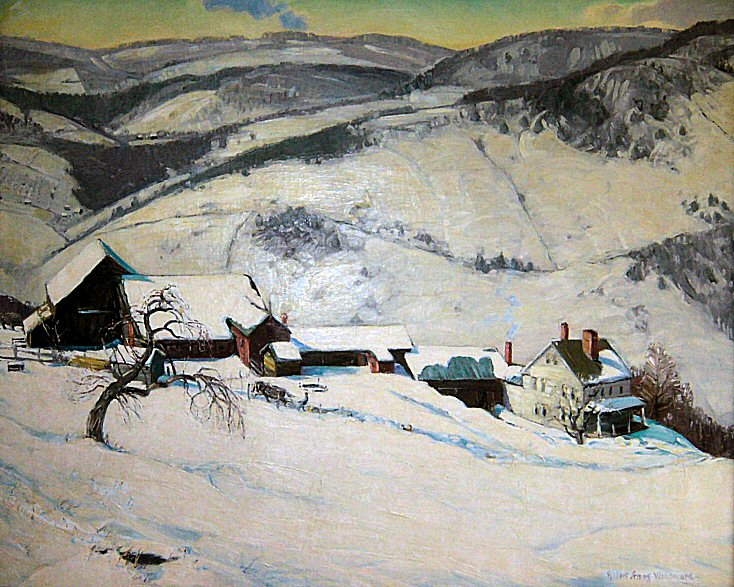
 New England Drama
New England Drama
For some additional context, 1930 was a BIG year for Boston because it was the 300th anniversary of the city's founding. This traditional "Art Week" celebration was especially heightened with many saying it was the best event in more than a decade. Following this there would be the special exhibition held at the Horticultural Hall building on Tremont Street where Woodward would win one of four gold medal honors of the event and be the only landscape artist to do so with his painting, New England Drama. Finally, after this event, October Gold would go to the Myles Standish Gallery and appear in the Boston Globe's Rotogravure Section. Months later the painting Winter Silence will also appeared in the Rotogravure. The year 1930 was the artist's big breakout year... perhaps the biggest of his career. Keep going ⮟
---------------------------------------------------------------------------------------------------------------------------------
⮟ Boston Globe, Rotogravure Section, June 29, 1930

 The Rotogravure section of the Sunday Boston
The Rotogravure section of the Sunday Boston
Globe is an honor in and of itself. It is a printing format
most commonly used by magazines. Woodward would
be honored twice by the Globe in 1930 for this and
later in December featuring Winter Silence
Regarding Provenance:
Mrs. Everett purchased October Gold some time around 1932 and died in 1938. According to a letter from her attorneys Mrs. Everett willed her Woodward collection as follows: the Pasadena Museum of Fine Art gets first choice, followed by the San Diego Museum of Fine Art. Artwork not chosen will be sold at auction. However, the attorneys for Mrs. Everett makes no mention of October Gold in their letter to Woodward.
 Woodward, however, does make note in his diary that October Gold was
willed to the San Diego Museum of Fine Art. He knows this because he does not begin to compile a painting diary
until the early 1940s was the suggestion of Dr. Mark
and encouraged by his friend F. Earl Williams.
Woodward, however, does make note in his diary that October Gold was
willed to the San Diego Museum of Fine Art. He knows this because he does not begin to compile a painting diary
until the early 1940s was the suggestion of Dr. Mark
and encouraged by his friend F. Earl Williams.
 The remaining knowledge regarding the provenance of October Gold comes
from the current owners providing us access to the painting itself which reads like a suitcase with location stickers
covering its exterior... continued below ⮟
The remaining knowledge regarding the provenance of October Gold comes
from the current owners providing us access to the painting itself which reads like a suitcase with location stickers
covering its exterior... continued below ⮟
Additional Pictures
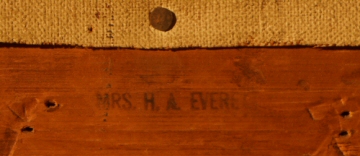
Stamp of Mrs. Everett's name
Regarding Provenance Continued:
As seen in the pictures, the stretcher is marked with numerous clues to it's time at CalTech. There is a stamp (upper left) of Mrs. Everett's name. We do not know who made the mark. Perhaps it was the those assigned to execute her estate. It appears to be a hand stamp which would have had to been made special and to go to such trouble indicates a large number of items.
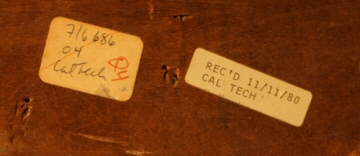
CalTech labels - one showing received Nov. 11, 1980
To the right we see two labels noting CalTech. It appears that receipt of the painting by CalTech was on November
11, 1980. It also appears it was given an id number or some sort of way to identify it for their records. ⮞
We did learn recently the Mrs. Everett's home was once occupied by JPL, Jet Propulsion Laboratories shortly after
WWII, and JPL has a long standing affiliation with CalTech.
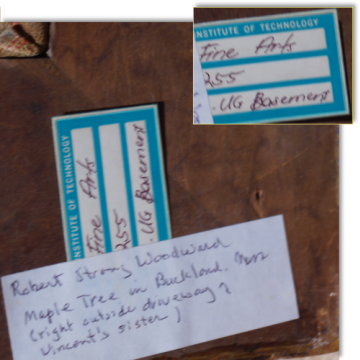
More labels- Cal-Tech inventory and a description
⮜ To the Left is another label regarding CalTech, partially covered by a recent label with a hand-written description of the painting's origin. The CalTech label appears to note where the painting was stored but the other label prevents us from seeing more.
⮜ More on these two labels, the one over top of the other says:
-- Robert Strong Woodward
-- Maple Tree in Buckland, Mass
(right outside driveway of Vincent's sister)
⮝ Huh? Who wrote that label and WHEN was it written? It is over top of a CalTech sticker so it was somewhere between Mrs. Everett, CalTech and Mr. Holland. It is completely wrong, but still, it leaves so many questions.
♦ We want to take a moment to address the gift to the San Diego Museum of Art. We are not sure the painting ever made it to San Diego. Much of the art gave to the Pasadena Museum was sold off when it began to struggle. How little to nothing is known about the canvases dedicated to San Diego. The fact it ended up at CalTech, which is in Pasadena, we wonder if it ever left the city.
Famous Owners

 The Pasadena Post
The Pasadena Post
June 28, 1928
------------------------
This is the only known picture
to exist of Mrs. Everett.
Mrs. Josephine Everett of Cleveland, OH, was a leading advocate of the arts, as well as a assiduous collector of art.
In terms of legacy, she has two. One is her collection of art to the Cleveland Museum of Fine Art in her daughter's name,
The Dorthy Burnham Everett Collection. The other is
that Josephine is credited with writing the check that bought the land that the Hollywood Bowl would be built.
She is one of Woodward's most faithful customers and patrons. She frequently lent portions of her collection to exhibit
at fine museums, and local art associations such as the Los Angeles County Museum of Art, as well as a supporter of the
Pasadena (CA) Museum of Art and the San Diego (CA) Museum of Art
We do not know when the two came to know each
other. Woodward spent many years of his youth in Ohio, the closest to Cleveland being Akron, and he lived near the
Everetts
when he moved to California. This may be one of the only instances his father Orion's work as a real estate developer
may have benefited his son. It is very likely, the relationship began in California when Orion was involved in the
development of the Balboa Recreational Area for the Pasadena light rail (trolley) system for which Mr. Everett was
also involved. It is hard to explain how special their relationship was. Early in Woodward's career, when a painting
was successful at some show or event, he often made another version of it and sent it to her in Pasadena. We actually
have no idea how many paintings she had because we keep finding more than listed by the lawyers.
---------------------------------------------------------------------------------------------------------------------------------

 Actor Joseph Holland
Actor Joseph Holland
It is rare for a painting to have one famous owner let alone FOUR! Besides Mrs. Everett, there is CalTech, JPL, and finally Mr. Joseph Holland... The painting is the most traveled canvas we know.
Famous stage actor Joseph Holland, who in the role of Caesar, was reportedly stabbed, for real, on stage by Orson Welles
(in the role of Brutus), opening night of the 1937 Mercury Theater's production of William Shakespeare's Julius Ceasar.
It is unknown how Mr. Holland came into possession of October Gold, once in the collection of CalTech University
but October Gold was not the only Woodward he owned. He also owned, Winter Design
so it is very likely he knew of Woodward prior to purchasing October Gold.

.png)
